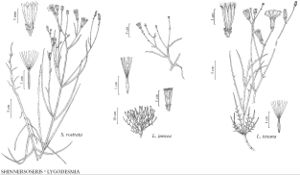Shinnersoseris
Sida 5: 186, figs. 1–3. 1974.
| Taxon | Illustrator ⠉ | |
|---|---|---|
 | Shinnersoseris rostrata Lygodesmia juncea Lygodesmia texana | Bee F. Gunn Bee F. Gunn Bee F. Gunn |
Annuals, 5–85 cm (herbage glabrous); taprooted (roots deep, slender to thick). Stems usually 1, erect, simple proximally, branched distally, glabrous. Leaves cauline (opposite proximally); ± sessile; blades linear to filiform, margins entire. Heads borne singly. Peduncles not inflated distally, usually bracteate. Calyculi of 8, ovate to lanceolate bractlets. Involucres narrowly cylindric, 4–5 mm diam. Phyllaries 8 in 1–2 series, linear, margins scarious, apices acute (keeled). Receptacles flat, pitted, glabrous, epaleate. Florets 8–11; corollas pale-purple or lavender, with white-tips. Cypselae pale green or tan, subcylindric to ± fusiform, apices abruptly constricted, not beaked, ribs 8–10, scabrous distally; pappi of 30–50, basally connate, white, ± equal, smooth or barbellulate bristles in ± 1 series. x = 6.
Distribution
c North America
Discussion
Species 1.
Shinnersoseris rostrata was included in Lygodesmia; Tomb presented evidence for placing it in a separate genus. It differs from Lygodesmia in having opposite proximal leaves, shorter, obscure ligules, shorter style branches, 8–10-ribbed cypselae, echinate pollen, and a different base chromosome number (x = 9 in Lygodesmia.)
Selected References
None.
Lower Taxa
"fine" is not a number.